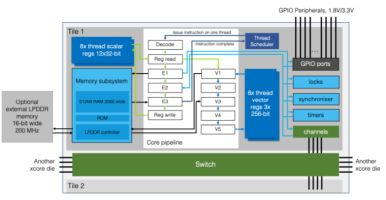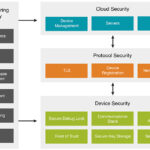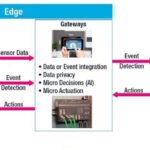A new processor called xcore.ai for the AIoT market delivers high-performance AI, DSP, control and IO in a single device with prices from $1.
Traditionally this type of capability would be deployed either through a powerful (and costly) applications processor or a  microcontroller with additional components to accelerate key capabilities. However, the new xcore.ai crossover processor from XMOS is architected to deliver real-time inferencing and decisioning at the edge, as well as signal processing, control and communications, enabling electronics manufacturers to integrate high-performance processing and intelligence economically into their products.
microcontroller with additional components to accelerate key capabilities. However, the new xcore.ai crossover processor from XMOS is architected to deliver real-time inferencing and decisioning at the edge, as well as signal processing, control and communications, enabling electronics manufacturers to integrate high-performance processing and intelligence economically into their products.
Today’s smart devices typically require energy-hungry and costly connectivity to the cloud. This comes marred with challenges around latency, connectivity, privacy and energy consumption. By providing efficient, high-performance compute at the edge, xcore.ai delivers solutions to each of these challenges while keeping cost low and design potential high.
xcore.ai heralds an entirely new generation of embedded platforms. It’s the most versatile, scalable, cost-effective and easy-to-use processor on the market today. With its fast processing and neural network capabilities, xcore.ai enables data to be processed locally and actions taken on-device — within nanoseconds. In the rapidly evolving AIoT ecosystem, this enables manufacturers to build smarter sensing technology that fits seamlessly into our lives. But what does this all mean in reality and can xcore.ai help to change the user experience for the better?
Imagine the humble smoke detector. Its come a long way since the first alarm was patented in 1890. But how can we truly optimize the smoke detector to dramatically reduce risk and support rescue and recovery?
With xcore.ai embedded, a smoke detector could use radar and imaging to identify whether there are people in the affected building and, if so, determine how many and where they are located. Using voice interfaces, the detector could communicate with those inside, while vital sign detection could identify whether they are breathing. Put together, this builds an intelligent picture of the environment that can be fed straight to the emergency services, enabling an informed rescue operation, improving accuracy and speed of response.
Programmability
Fully programmable in ‘C’, with specific features such as DSP and machine learning accessible through optimized C-libraries
Supports the FreeRTOS real-time operating system, enabling developers to use a broad range of familiar open-source library components
TensorFlow Lite to xcore.ai converter, allows easy prototyping and deployment of neural network models
Connectivity
Up to 128 pins of flexible IO (programmable in software) give access to a wide variety of interfaces and peripherals, which can be tailored to the precise needs of the application
Integrated hardware USB 2.0 PHY and MIPI interface for collection and processing of data from a wide range of sensors
Binarised neural networks
Employs deep neural networks using binary values for activations and weights instead of full precision values, dramatically reducing execution time
By using binary neural networks, xcore.ai delivers 2.6x to 4x more efficiency than its 8-bit counterpart.
XMOS, Queens Quay, 33-35 Queen Square, Bristol, BS1 4LU, http://xcore.ai/




Leave a Reply